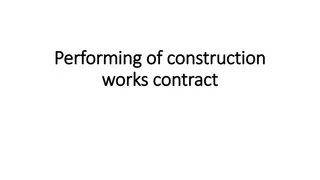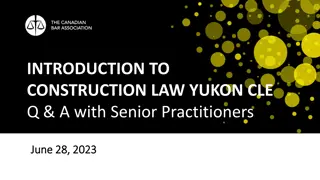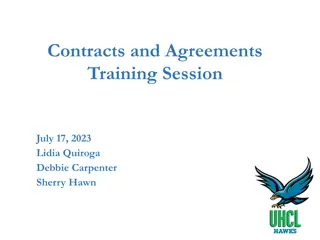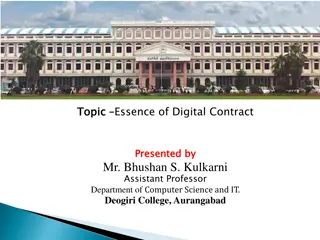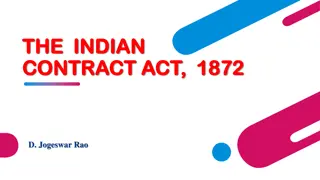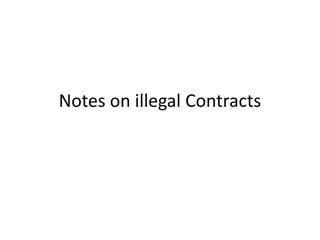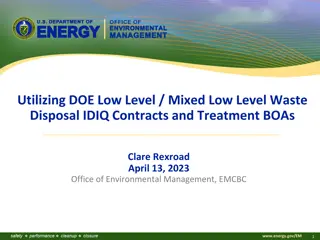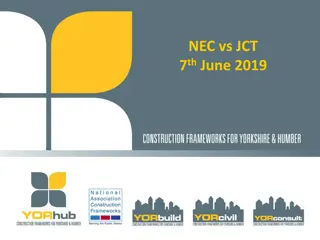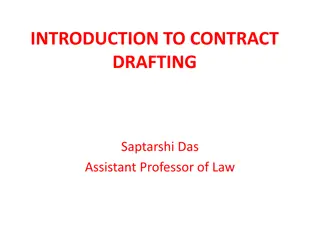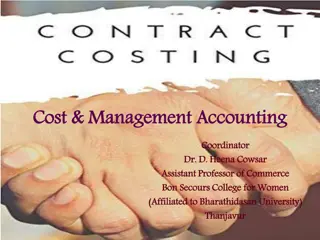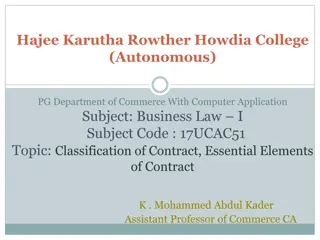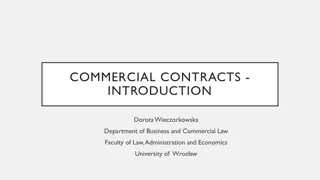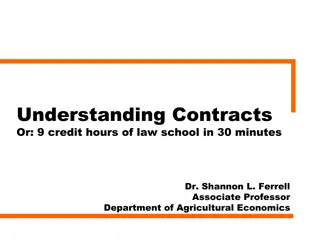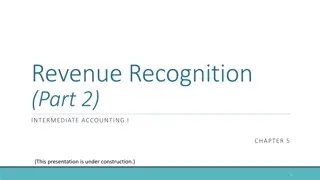Understanding Different Types of Contracts in Construction Management
Contracts in construction management play a vital role in defining the obligations and responsibilities of parties involved. This content covers the basics of contract management, types of contracts such as lump sum, cost-plus, and time and material contracts, each serving different purposes based on project scope and requirements. These contracts vary in terms of pricing, risk allocation, and flexibility, offering insights into how to choose the most suitable contract type for construction projects.
Uploaded on Sep 09, 2024 | 0 Views
Download Presentation

Please find below an Image/Link to download the presentation.
The content on the website is provided AS IS for your information and personal use only. It may not be sold, licensed, or shared on other websites without obtaining consent from the author. Download presentation by click this link. If you encounter any issues during the download, it is possible that the publisher has removed the file from their server.
E N D
Presentation Transcript
WELCOME TO LECTURE 2 SELESTIAN AUGUSTINO
1.4.0 Contract Management A contract is a voluntary, deliberate, and legally binding agreement between two or more competent parties which is enforceable by the law. Contracts are usually written but may be spoken or implied. A contractual relationship is evidenced by (1) an offer, (2) acceptance of the offer, and a (3) valid (legal and valuable) consideration. Each party to a contract acquires rights and duties relative to the rights and duties of the other parties. One may say, a contract is an agreement made between two or more parties that creates legally binding obligations between them. The contract sets out those obligations and the actions that can be taken if they are not met.
1.4.1 Types of contract i. Lump sum or fixed price contract type This type of contract involves a total fixed priced for all construction-related activities. Lump sum contract can include incentives or benefits for early termination, or can also have penalties, called liquidated damages, for a late termination. Lump Sum contracts are preferred when a clear scope and a defined schedule has been reviewed and agreed upon. This contract shall be used when the risk needs to be transferred to the builder and the owner wants to avoid change orders for unspecified work. However, a contractor must also include some percentage cost associated with carrying that risk. These costs will be hidden in the fixed price. On a lump sum contract, it is harder to get credit back for work not completed, so consider that when analysing your options.
1.4.1 Types of contract ii. Cost plus contracts This type of contract involves payment of the actual costs, purchases or other expenses generated directly from the construction activity. Cost plus contracts must contain specific information about a certain pre-negotiated amount (some percentage of the material and labor cost) covering contractor s overhead and profit. Costs must be detailed and should be classified as direct or indirect costs. There are multiple variations of cost plus contracts and the most common are: Cost plus fixed percentage Cost plus fixed fee Cost plus with guaranteed maximum price contract Cost plus with guaranteed maximum price and bonus contract
1.4.1 Types of contract ii. Cost plus contracts Cost plus contracts are used when the scope has not been clearly defined and it is the owner responsibility to establish some limits on how much the contractor will be billing. When some of the aforementioned options are used, those incentives will serve to protect the owner's interest and avoid being charged for unnecessary changes. Be aware that cost-plus contract are difficult or harder to track and more supervision will be needed, normally do not put a lot of risk in the contractor. iii. Time and material contracts Time and material contracts are usually preferred if the project scope is not clear, or has not been defined. The owner and the contractor must establish an agreed hourly or daily rate, including additional expenses that could arise in the construction process.
1.4.1 Types of contract iii. Time and material contracts Sometimes the owner might want to establish a specific project duration to the contractor that must be met, in order to have the owner s risk minimized. These contracts are useful for small scopes or when you can make a realistic guess on how long it will take to complete the scope. iv. Unit pricing contracts Unit pricing contracts is probably another type of contract commonly used by builders and in federal agencies. Unit prices can also be set during the bidding process as the owner requests specific quantities and pricing for a pre-determined amount of unitized items. Unit price can easily be adjusted up and/or down during scope changes, making it easier for the owner and the builder to reach into agreements during change orders.
1.4.2 Contract documents Construction contract agreement A construction contract agreement is a document that sets a date and specifies which parties are going to participate in the construction process. Usually, the contract agreement is executed between the owner of the project and the contractor or supplier that is providing the requested services and contains several sections of clauses defining the scope, terms, and conditions of such agreement.A contract agreement should have sections like project description, contract price, payment basis, construction schedule or calendar, construction scope, construction conditions and responsibilities and contract laws. Scope of work or statement of work The scope of work document describes all of the work to be done on a project, who is responsible for completing the work, how the work must be performed (techniques used), and what materials will be used.
1.4.2 Contract documents Construction schedule The construction schedule is an important component of the larger document and second only to the construction contract agreement. This component allows the contracting client to know how and when the project will be completed and offers them leverage when schedule problems arise. General conditions The General Conditions portion of an overall construction contract is the portion that sets forth the right, responsibilities, and relationships between the client and contractors. Most important is the rights and responsibilities of each party. The general conditions portion of the contract offers the legal framework for the overall construction contract.
1.4.2 Contract documents Special Conditions This is usually an extension of the contract and an addendum to the general conditions. The special conditions document should specify certain conditions and clauses that pertain to specific portions of the job. For example, if there are specific instructions that apply to only one portion of the job, the special conditions section is where this will be described. Specifications The specifications section of a contract is where all the technical data and requirements are listed. Information should detail all the materials and techniques that are expected to be used. These specifications should be discussed and negotiated at the time the contract is developed, and later changes to the specifications are often handled under whatever conditions are laid for change.
1.4.2 Contract documents Bill Of Quantity(BOQ) This document comprises lists of diverse trades and materials that will form part of the construction. It includes an itemized list on the costs of materials, parts, and labor that will be part of the construction project. This document is essential for allowing a contractor to properly bid a project. Sometimes this document is omitted since it is not always required by the contracting officer. Cost Estimate This portion of the construction contract agreement provides a breakdown of all items being incorporated into the construction project and their costs. The cost estimate can be detailed per item in a document that combines specifications and costs, or in a lump sum form that doesn't specify individual items. Sometimes an itemized cost estimate is combined with the specifications in a single section.
1.4.2 Contract documents Drawings All contracts should include a set of whatever drawings that are applicable to the work being performed. This might include the actual blueprints for the project, or it may be one or more simpler drawings that provide a graphic representation of the scope, extent, and character of the work that will be performed by the contractor. List of construction insurance coverage This is an essential part of the agreement because it provides a guarantee to the owner that the contractor has the means and the economic backup to perform under the terms of the construction contract. It will include details on specific types of coverage, including general liability insurance, performance bonding, and builder's risk insurance.
1.4.3 Possible contract obligations Concept of contract obligations Contract obligations are those duties that each party is legally responsible for in a contract agreement. In a contract, each party exchanges something of value, whether it be a product, services, money, etc. On both sides of the agreement, each party has various obligations in connected with this exchange. Some examples of contract obligations are; Payment: One party (the client/owner) is usually legally bound to provide payment for the work/products/services. The contract terms may state obligations regarding payment amounts and the deadline for payment. Delivery: The contractor is usually bound to provide delivery of the work/products/services.Again, the contract may state specific obligations in terms of delivery dates, method of delivery and other terms. Quality of work: The contractor may also be bound to provide work of a certain quality. This may be specifically described in the contract.
1.4.4 Specification Meaning of specification A specification is a specific description of a particular subject. An engineering specification contains detailed description of all workmanship and materials which are required to complete an engineering project in accordance with its drawings and details. The cost of a unit quantity of work is governed by its specification. It is an essential contract document and is required for Arbitration or court cases. It is also necessary to specify the equipments, tools and plants to be engaged for a work and thus enables to procure them beforehand. Types of specification i. Brief specification (General specification) ii. Detailed specification
1.4.4 Specifications Brief specification (General specification) This type of specification do not describe any particular item of work but refer to a complete work. The general specification is mainly suitable for estimating the project but do not formm part of contract document. It states in brief description of various items of the work specifying materials, proportions, qualities etc. General specification just draw the outline of nature and class of work. Detailed specification This type of specification describe particular item of work in detail. They form a part of contract document. On reading these specifications, a reader will get clear cut idea regarding the quality or material, workmanship and mode of payment. The detailed specification for various items of work are prepared separately.
1.4.5 Tender Meaning of tender Tender is a written offer submitted by the contractors in pursuance of the notification given to execute certain work under certain terms and conditions as laid down in the tender documents. On obtaining sanction of the detailed estimate, tender documents are prepared and tenders are invited from the intending tenderers, either classified enlisted contractors or open tender allowing tenderers other than enlisted to participate. While allowing any outside tenderer, other than enlisted registered, his/their bona fide, competence, experience, financial capability, etc., are verified.
1.4.6 Tender notice The notice inviting tender is a very important document on which tenders and subsequently agreements with the contractors are based. The tender notice should stipulate short description of the work, period of construction, date and time for submission of the tender, amount of earnest money to be deposited, manner of depositing the earnest money, estimated amount of the tender, source of receiving the tender documents and the name and address of the officer/person to whom the completed tenders are to be deposited and any important information which need be communicated to the tender. Detailed tender notice A detailed tender notice comprises of the full tender documents and kept in selected offices for inspection of the intending tenders.
1.4.6 Tender notice Essentials of tender notice are; Implementing agency Project name Notice number First date of publication Contract number Description and location of work Bid security/earnest money deposit Fee for bid document Last date of submission of bid Office for buying bidding document and submit tender
1.4.6 Tender notice Essentials of tender notice are; Bid opening date Cost estimate of the project Date, place and time of opening the tender Maximum number of joint venture Study two sample tender notices presented in the next slide
1.4.7 Types of tender Open Tender Open tender is the main tender employed by both the private sector and the government. The client advertises the tender offers in the local newspaper along with the key information of the proposed works and inviting interested contractors. The tender notification includes an invitation to treat, a mere request by the employer for a suitable contract to submit their bids or offers. Selective Tender Selective tender is the one alternative developed to address the limitation of the open tender. Here a short list of contractors is drawn up and they are invited to submit tenders. The purpose of this tender is to improve the quality of bids received to ensure that the contractors with necessary experience are given a chance to submit the necessary bids for the specific reason of the employer.
1.4.7 Types of tender Negotiation Tender This type of tender is widely used in the engineering and construction industry commencing from tendering until the resolutions of the disputes, which comes under the pre-contract negotiations and the post-contract negotiations. Usually, a single contractor is included but can be scaled into 3 contractors. Term Tender Term tender is normally used on projects that need huge maintenance. The contractor will be asked to cover a range of different buildings in different locations. It is often limited to a fixed time scale although the needs of the client may require this to be extended. This is generally a standing offer to undertake a loosely defined extends of work usually within a fixed amount of time.
1.4.8 Tender document Tender document/bidding document is a document prepared by the owner for submission by bidders by filling up the price or rate. Tender document includes the following important informations; i. Instructions to bidders ii. Specifications iii. Design iv. Drawings v. Terms of reference vi. Schedule of work vii. Evaluation criteria viii. Bill of quantities ix. Condition of contract
1.4.8 Tender documents Tender documents comprise of three parts and are submitted in standard printed forms: Part I: Contains notice inviting tender, general description of the work, general rules and directions, terms and conditions of the proposed contract, schedule of materials with prices proposed to be issued by the department, earnest money to be deposited prior to tendering, security deposit to be deposited on acceptance of the offer or prior to executing the contract and time for completion of the work. This part is applicable to tenders of all kinds of works. Part II: Contains technical specifications for materials and workmanship and any special condition applicable to any particular item of work and a complete set of necessary drawings explaining the proposed work.
1.4.8 Tender documents Part III: Contains schedule of items of works with quantity, unit and estimated rates. Invitation of Tender Tenders are invited from the intending participants by issuing a notice mentioning the required information at least 15 days prior to the date of submission of the tender. The tender notice is displayed in all possible places and giving an insertion in the newspapers for making a wide publicity.
1.4.9 Earnest Money Deposit(EMD) and Security Deposit(SD) Earnest Money Deposit(EMD) Earnest money is the amount the intending tenderer is asked to deposit prior to tendering, demonstrating his earnestness for the tender. This is generally 1% to 2% of the estimated value of the tender and is asked to deposit one day prior to the date of submission of the tender. The earnest money of the unsuccessful tenderer is refunded without payment of any interest for the period of retention of the money in the custody of the owner. Security Deposit(SD) Security deposit is the amount which the tenderer, whose tender has been selected for acceptance, is asked to deposit before acceptance of the tender or execution of the agreement. This amount varies from 5% to 8% of the value of the tender after consideration of the contractual percentage, inclusive of the amount already deposited as earnest money.
1.4.10 Scrutiny and acceptance of tender Scrutiny can provide all the necessary documentation to carry the tendering process forward, and then provide the analytical expertise to ensure that all bids are measured on a comparable basis to ensure the correct award criteria. Every tender committee constituted must go through the tenders, comparative statement and briefing notes and consider the tenders and frame their recommendations. It should be ensured that there is no delay in finalizing the minutes of tender committee and as far as possible the draft of minutes should be finalized by the tender committee at the meeting itself. Under no circumstances any of the members of the tender committee should refer the tender case to any officers/staff under him or to any one else for scrutiny and/or comments. The proceeding of the tender committee should be signed by the members of the tender committee on each and every page. The recommendations of tender committee are to be put up direct to the accepting authority for tender acceptance, without further recommendations or comments from any one.
1.4.11 Construction contract agreement A construction contract agreement is a document that sets a date and specifies which parties are going to participate in the construction process. Usually, the contract agreement is executed between the owner of the project and the contractor or supplier that is providing the requested services and contains several sections of clauses as listed here under; i. Project description ii. Contract price iii. Payment basis iv. Construction schedule or calendar v. Contract document list vi Construction scope vii. Construction conditions and responsibilities viii. Contract laws
1.4.12 Contractual changes and termination of contract Contractual changes Changes in the relevant law can affect the way work is performed under a contract. Contractors will generally be obliged to complete the work in accordance with local building regulations and other laws. If the law changes during the term of a construction project, this can have cost implications for the contractors. If the law or the contract itself does not say otherwise, parties to a contract can change it by oral or written agreement. But for this changes to be effective there must be: A valid agreement between the parties Some form of consideration supporting this agreement
1.4.12 Contractual changes and termination of contract Termination of contract There are 4 main ways to terminate a contract: Performance The contract runs its course, and the contract is performed. If the tendered performance is refused by the other party, they may be sued for breach of contract. Agreement The parties agree to end the contract by agreement Breach When one party expresses an intention to perform the work in a way in which is inconsistent with the original contractual terms, it is an anticipatory breach. It entitles the other party to terminate. Frustration Discharge by frustration occurs where it is impossible to perform the obligations under a contract due to a change in circumstances of performance of the contract after it has been signed.
1.4.13 Subcontract Subcontract is a contract between a party to an original contract and a third party especially one to provide all or a specified part of the work or materials required in the original contract. One may say, it is an agreement for an outside person or organization to do work that might normally be done within an organization. Subcontractor is a company or person who is hired by a general contractor (or prime contractor, or main contractor) to perform a specific task as part of the overall project and is normally paid for services provided to the project by the originating general contractor. Types of subcontractors i. Domestic subcontractor ii. Nominated subcontractor iii. Named subcontractor
1.4.14 Rights and duties of subcontractor Rights of subcontractor Subcontractor rights are governed by the contract. The general contractor and client are bound by the terms of the agreement they sign. The subcontractor takes responsibility for seeing that his portion of the contract is completed according to the agreement. If a subcontractor feels that the contractor or client has violated the contract, he is entitled to sue for damages. The subcontractor can file a mechanic's lien against the property for unpaid wages and expenses. He also has the right to work in a safe and healthy environment. Duties of subcontractor Subcontractors have to comply with the terms of the contract as well. They are held accountable for their work by the contractor and the client. Frequent communication between the subcontractor, general contractor and the client helps to avoid problems down the road. They should be flexible and willing to adjust to policy and procedure changes. They must complete projects by their due dates and stay within a predetermined budget. High quality work is important because it reflects on them as well as the general contractor.
EXERCISE 1 2 Marks questions 1. What does the term construction mean?. 2. How does construction industry differ from manufacturing industry?. 3. Define building construction. 4. What is construction project management?. 5. Brief about construction management. 6. With diagram, shortly explain about iron triangle. 7. Explain the concept of project feasibility study. 8. Name the two criteria used to judge feasibility. 9. Mention the four (4) categories of analysis in project feasibility report. 10. What do you mean by project?.
11. What do you mean by contract?. 12. Define the term specification. 13. Name two types of specification. 14. Meaning of tender?. 15. List any four (4) important information in tender document. 16. What is subcontract and who is subcontractor?. 17. Point out the types of subcontractor.
4 Marks questions 1. Name the objectives of construction management. 2. Classify the construction based on materials used. 3. Explain types of construction sector with concrete examples. 4. Explain the four (4) design steps in construction of a project. 5. Define the five (5) stages in construction of a project. 6. Discuss the economical analysis in the project feasibility report. 7. Highlight the five (5) stages in project planning by client and contractor?. 8. Discuss the types of contract. 9. Construction contract agreement has several sections of clauses. Briefly explain any four (4) of them.
10. Discuss the types of tender. 11. Briefly explain about (EMD) and (SD) with estimated values. 12. Discuss the four (4) main ways to terminate a contract.
12 Marks questions 1. What are the functions of construction management?. 2. Enumerate the duties and responsibilities of project owner. 3. Explain in detail duties and responsibilities of consultant. 4. How is technical analysis achieved in project feasibility report?. 5. What are the objectives of civil engineering project planning?. 6. Discuss the advantages of project planning in construction sector. 7. Discuss in detail about contract documents.
END OF LECTURE 2 THANK YOU SELESTIAN AUGUSTINO




